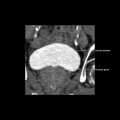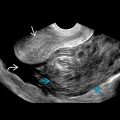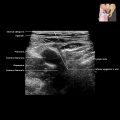KEY FACTS
Terminology
- •
Secondary sclerosing cholangitis usually resulting from opportunistic infection of biliary tract in AIDS patients with CD4 count < 100/mm³
Imaging
- •
Knowledge of HIV/AIDS status is key
- •
Intra- and extrahepatic bile duct strictures
- •
Thickened, edematous bile ducts
- •
Dilated common bile duct from papillary stenosis
- •
Combination of sclerosing cholangitis and papillary stenosis are unique to AIDS cholangiopathy
- •
Diffuse gallbladder wall thickening without gallstones
- •
Ultrasound usually followed by ERCP when tissue can be obtained for culture and therapeutic procedures, such as drainage, can be performed
Top Differential Diagnoses
- •
Primary sclerosing cholangitis
- •
Autoimmune cholangitis
- •
Ascending cholangitis
- •
Cholangiocarcinoma
Pathology
- •
Chronic inflammation of biliary tract from opportunistic pathogens
- •
Most common pathogens: Cryptosporidium, CMV
- •
Favors larger bile ducts
Clinical Issues
- •
Epigastric/right upper quadrant, diarrhea
- •
Fever and jaundice, less common
- •
Liver function tests may be abnormal
- •
Decreasing prevalence with improved therapy/prophylaxis of patient with HIV infection
Scanning Tips
- •
Use high-resolution transducer to look for bile duct wall thickening and gallbladder thickening










